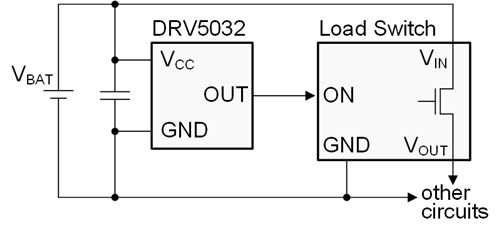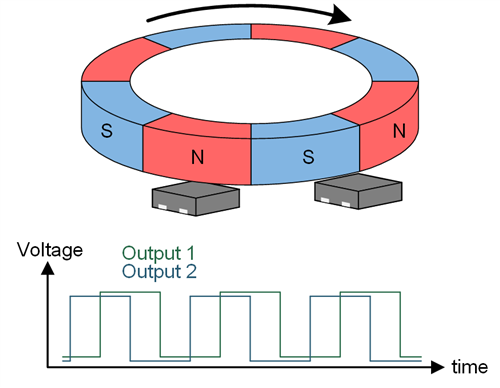SSZT892 November 2017 DRV5012 , DRV5032
Although many electronics engineers have their heads buried in schematics, capacitors, amplifiers, voltages, frequencies, timings and impedance, real-world implementations take form as physical systems that have to fit within the final product and interface electrically and mechanically with everything on the outside. While the mechanical work is usually tackled by mechanical engineers, there’s a lot that electrical engineers can bring to the table by designing with magnetic sensors.
Do you want to build a device that magically comes to life when the user moves one of the components? It could be a coffee maker, a seat detector, a leather phone cover, a robot, an appliance – or some other gadget that doesn’t even exist yet. A well-positioned Hall effect sensor and corresponding magnet can be your position sensor, acting invisibly to the user.
For on/off proximity detection, TI has a new ultra-low-power family of Hall switches, the DRV5032. With the lowest-power version operating from a scant 0.54 µA from 1.8 V, it won’t drain batteries when the rest of the system is off, and the sensor can act as a front-end power gate for waking up the rest of the system, as shown in Figure 1. The TI TechNote, “Power Gating Systems with Magnetic Sensors,” elaborates on this type of usage.
 Figure 1 Magnetic Sensor Power Gate
Circuit
Figure 1 Magnetic Sensor Power Gate
CircuitOr maybe what you need is to somehow translate rotational movement into digital data. It could be from a motor, human-interface knob, fan, wheel or impeller that turns as fluid moves by. A simple and robust way to do this is to attach a multipole magnet to the rotating component and position stationary Hall latch devices nearby. As the component rotates, alternating north and south magnetic poles move by the sensors, causing them to generate high and low pulses that are easy for a microcontroller to interpret. Using two sensors provides directional information, since the order of 2-bit states can be compared. Figure 2 shows this.
 Figure 2 Magnetic Incremental Rotary
Encoder
Figure 2 Magnetic Incremental Rotary
EncoderThe new DRV5012 is an ultra-low-power Hall latch that can be used for this. With its pin-selectable sampling rate, the device can either sample at 20 Hz using 1.3 µA, or 2.5 kHz using 142 µA, for optimal power consumption based on the rotational speed needed. The TI TechNote, “Incremental Rotary Encoder Design Considerations,” describes more information.
Demo
To help demonstrate the practicality of these ultra-low-power position sensors, TI released a solar-powered evaluation module. Using just the ambient light of a room, the solar cell provides ample power for the DRV5032 Hall sensor and flashes the LED when the magnetic threshold is crossed. Although a standard CR2032 battery can power a DRV5032 for 20 years, using a solar cell can further extend the life and provide extra power for the rest of the system.
Unconventional Uses
Ultra-low-power Hall effect devices also have unconventional applications:
- Hidden test modes. Products can embed Hall switches that are hidden from the user and only used to enter a test mode when a technician brings a magnet close. This might be the simplest 1-bit wireless communication method out there.
- Mechanical tamper detection. In order to detect if someone unscrews a chassis (whether a thermostat, alarm system, smoke detector or computer server), a Hall switch can be positioned next to a magnet for normal operation, and if the two become separated the controller will know tampering has occurred.
- Electricity meter tamper detection. Some people try to steal electricity by placing a strong magnet against an electricity meter, which can saturate the transformer. Hall switches can detect this.
- Latched power enable. Small medical devices like hearing aids or endoscopy medical pills might have no mechanical access points, and a low-power Hall latch can effectively activate the rest of a power-hungry system.
So don't let mechanical engineers take all the glory for superb mechanical designs, when you can be an electromechanical engineer.
Additional Resources
- Read more Hall effect sensor blog posts:
- “Measuring wheels in motion.”
- Watch the Hall effect sensor training video.
- Check out these reference designs: